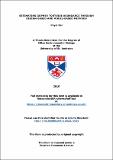Files in this item
Estimating gopher tortoise abundance through design-based and model-based methods
Item metadata
| dc.contributor.advisor | Thomas, Len | |
| dc.contributor.author | Bal, Payal | |
| dc.coverage.spatial | v, 52 | en_US |
| dc.date.accessioned | 2010-12-14T09:10:32Z | |
| dc.date.available | 2010-12-14T09:10:32Z | |
| dc.date.issued | 2010 | |
| dc.identifier.uri | https://hdl.handle.net/10023/1636 | |
| dc.description.abstract | Gopher tortoises are a small land tortoise that inhabit south-eastern United States and are listed as threatened due to habitat loss. They are rather hard to survey, since they occur at low density. This project was based on extensive data from systematic line transect surveys for gopher tortoises at Fort Gordon and Ichauway in Georgia, USA, collected by the Joseph W. Jones Ecological Research Centre. Despite excellent survey designs and field methods, the resulting estimates of abundance have shown high variance. Alternate methods for abundance and variance estimation that could lower the variance were explored. Both, design-based and model-based approaches to abundance estimation were attempted. For the design-based approach, abundance and associated variance estimates were obtained using the CDS/MCDS analysis engines in DISTANCE (Version 6.0). The cluster size estimation technique to scale burrow to tortoise abundance was used. Variance of the encounter rate component, that usually dominates the overall variance estimate for line transect data was originally calculated using the R2 estimator (used in DISTANCE 6.0 as the default) that is suited for random line placement. This was compared against encounter rate variance estimators developed for systematic designs (Fewster et al. 2009). As expected, the latter produced substantially lower variance estimates. For the model-based approach, abundance as well as occupancy was modelled by specifying GAMs using environmental covariates (where available) for the study sites. Resulting predictions were subjected to non-parametric and parametric bootstrapping for variance estimation. Parametric bootstrap suited to the model-based approach did not perform well because the underlying GAMs specified for burrow occupancy were found to be inaccurate. Due to the excellent design of the survey and the lack of sufficient information to model burrow occupancy accurately, design-based methods appeared to do better than the model-based methods for the data. The final estimates for both the study sites and the surface maps (only for Ichauway) produced need to be reviewed and must be considered in conjunction with the accompanying uncertainty. | en_US |
| dc.language.iso | en | en_US |
| dc.rights | Creative Commons Attribution-NonCommercial-NoDerivs 3.0 Unported | |
| dc.rights.uri | http://creativecommons.org/licenses/by-nc-nd/3.0/ | |
| dc.title | Estimating gopher tortoise abundance through design-based and model-based methods | en_US |
| dc.type | Thesis | en_US |
| dc.type.qualificationlevel | Masters | en_US |
| dc.type.qualificationname | MRes Environmental Biology | en_US |
| dc.publisher.institution | The University of St Andrews | en_US |
This item appears in the following Collection(s)
Except where otherwise noted within the work, this item's licence for re-use is described as Creative Commons Attribution-NonCommercial-NoDerivs 3.0 Unported
Items in the St Andrews Research Repository are protected by copyright, with all rights reserved, unless otherwise indicated.


